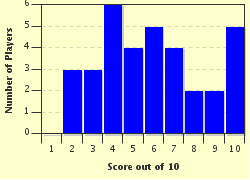Quiz Answer Key and Fun Facts
1. As the Earth healed from the devastating comet strike 16 million years prior, a 'New Dawn' approached. Dinosaurs couldn't adapt to the rapid changes, and they died out. The world was up for grabs, and in the dense forest of Germany, a top predator came forward; a leftover from the dinosaurs, a giant bird that terrorized the mammals. What was this terror bird?
2. Another resident in the dense forest was the aquatic predator called Ambulocetus. This three meter long mammalian predator would evolve into one of the most successful ocean dwelling species on Earth, and it's name says it all. What did it's name mean?
3. It is the Late Eocene, and sea levels have risen. The 'Whale Killer' has arrived. After Ambulocetus comes a mighty predator that ate other whales for lunch. What is this mighty beast?
4. On land, dense forests was turned to plains and beaches. Running along the beach was a huge predator, with some unusual features. It had hooves instead of claws, and a long jaw full of teeth. What is this 'sheep in wolf's clothing'?
5. It is now the Late Oligocene, we go to Mongolia, the 'Land of Giants'. True to the title, the main beast on this programme was a towering five meters tall, the Indricothere, or Paraceratherium. Which of these mammals its closest relative?
6. It is now the Late Pliocene and it is here in Africa, where we meet our 'Next of Kin'. Meet Australopithecus, an early hominid that did something incredible, they could walk upright. We follow a clan led by an old male named Grey, who's leadership is under threat by a younger, stronger rival. What name is given to this strong ape?
7. Tagging along with the clan is a young orphan. After his mother's death due to malaria, he is left alone due to lack of social skills, and is often neglected by the rest of the clan. What is the name of this sad outcast?
8. We now reach the once isolated continent of South America, the land of the 'Sabre Tooth'. It is the Early Pleistocene, just 1 million years ago, and we follow a pride of mighty Smilodon, the infamous Sabre-Toothed Cats. Their leader is a ragged old male, who has a bit of a chip on him. What's his name?
9. The Brothers dominated the pride, but luck was not on their side. A freak accident would change everything, and it involved a giant ground sloth. Which of these creatures is that sloth in question?
10. The Ice Age has arrived, and we move in the middle of a 'Mammoth Journey'. Along with the denizens of the icy cold plains are early man. We follow a tribe of tough Neanderthals in their hunt for mammoths. Reaching to a cliff face, the Neanderthals use a dangerous weapon against the Mammoths. What did they use to throw them off the cliff for an easy kill?
Source: Author
Abby_91
This quiz was reviewed by FunTrivia editor
ladymacb29 before going online.
Any errors found in FunTrivia content are routinely corrected through our feedback system.

